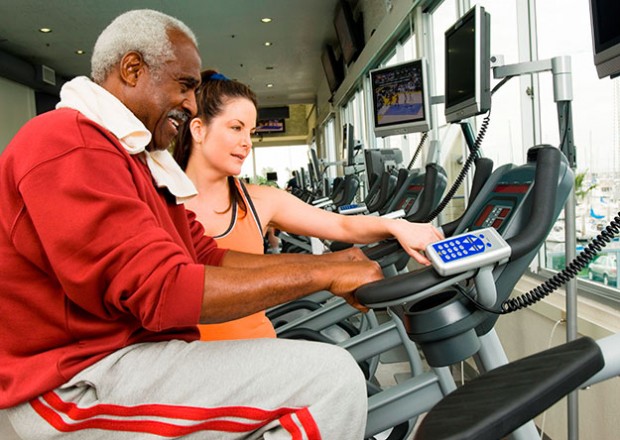Kauai Physical Therapy Blog
Home of Action Physical Therapy: Kauai's Premier Physical Therapy and Personal Fitness Clinic
Health & Nutrition
A New Therapy Instrument is Revolutionizing Stroke Rehab
Power Chord
At Action Physical Therapy, we all have our own opinions about who is making the best music these days. With flood of new artists pouring onto the scene, it’s hard to keep up. But something that we all agree on, is how powerful music can be in the recovery process. For decades, music therapy has been employed in rehabilitation programs and lauded for its positive impact.
Historically, music therapy has been in the form songs played or performed for the patient. But a recent advancement is changing the tune of music therapy, by putting it directly in the patient’s hands.
Flint Rehabilitation Devices has introduced a revolutionary tool in stroke rehabilitation with their MusicGlove, a computing device worn over the hand to help improve fine motor skills that have been compromised due to a stroke.
Combined with a specially fitted mobile tablet device, MusicGlove users play a Guitar-hero style game that can help them restore movement in their fingers and hands. In stroke therapy, massive repetition of movement to the affected parts of the body is proven to help the brain re-route neuronal circuits. This allows the patient to regain at least some (and sometimes all) of their motor function.
The problem with repetition is that it’s, well, repetitive and gets boring for the patient. Imagine repeating the same hand motion 1,000 times, every day for weeks or months at a time. When the patient’s therapy sessions have ended, and they are left to perform these exercises at home, compliance falls drastically. The MusicGlove is designed to make these repetitive (yet crucial) hand exercises fun and engaging.
The proof is in MusicGlove’s research, which has shown greater improvement in regaining motion when compared to conventional rehab exercises. And, patients stay more compliant with their at-home therapy.
Perhaps the best part of MusicGlove is its access. It has a relatively cheap price tag (at least when compared to other rehab medical devices), is completely portable, very easy to set up and use, and doesn’t require a doctor’s prescription. In fact, it’s even available on Amazon.
The MusicGlove’s versatility goes well beyond stroke therapy. Patients with brain, spinal cord, muscular, and other forms of neurological injury can also benefit from this exciting new technology. And that is music to our ears.
Motorized Stationary Bike May Help With Stroke Rehabilitation
It seems that exercising on a motorized stationary bike may help boost stroke patients’ brain and motor skills recovery.
 The study included 17 stroke survivors, all who took part in repetitive task therapy, such as relearning how to hold a cup or fork, or how to dress themselves.
The study included 17 stroke survivors, all who took part in repetitive task therapy, such as relearning how to hold a cup or fork, or how to dress themselves.
All patients did 24 exercise sessions over eight weeks. At the end of that time, the patients who used a motorized stationary bike showed a 34 percent improvement in motor skills, compared with a 16-17 percent improvement in the non-motorized stationary bike users.
Earlier research has shown that aerobic exercise helps the brain learn new information, and that forced exercise on a motorized stationary bike benefits Parkinson’s disease patients. Additionally, aerobic exercise may help enhance the brain’s ability to reorganize itself and form new connections, the study authors said.
The motorized stationary bike helped patients with limited mobility to pedal and achieve and maintain the intensity of training believed necessary to affect brain function, the researchers noted.
“Not only are we improving motor recovery with half the amount of task practice but we’re also improving cardiovascular health, and stroke patients often have cardiovascular (problems),” study author Susan Linder, a physical therapist at the Cleveland Clinic, said in a stroke association news release.
“If we can improve motor recovery and cardiovascular health simultaneously, patients can regain lost motor function and improve their quality of life.”
Kill All Pain!
A Clinical Pearl by Adriaan Louw, PT, PhD, CSMT
There is a wonderful article from Medbridge (medbridge.com) regarding a refreshing pain management strategy. “We know now: pain is a lot more complex and warrants a more comprehensive approach to make meaningful changes in our patients.”
“The day I found out that pain is a normal biological process aimed to protect us, it set me free. Pain is normal. Without the ability to experience pain, you wouldn’t survive very long. Now I feel much less pressure to “kill all pain” in my clinical practice. I became interested in the issues that keep the normal pain going longer than it biologically should, in coping skills and in teaching people that pain is a normal human experience. Guess what? My patients started having epiphanies and seeing pain as an informant rather than an enemy.”

Do you have diabetes? Are you sure?
8 Million Americans Don’t Know They Have Diabetes

A quarter of those in United States living with diabetes do not know they have it.
This fun fact courtesy of the US Centers for Disease Control and Prevention (CDC). Yup, an estimated 29.1 million people (almost 10% of the population) in the US have diabetes, but roughly 8.1 million of them (27.8%) haven’t been diagnosed. This information, along with a number of other new diabetes statistics, is featured in the CDC’s 2014 National Diabetes Statistics Report, which is based on data from 2012.
The report also found the diabetes rate for:
- Hispanics is 12.8%
- non-Hispanic blacks is 3.2%
- Native Americans/Alaska Natives is 15.9%
- non-Hispanic whites is 7.6%
- Asians is 9%.
Please get checked by your primary care physician or ask for our help at Action PT.
Stand at Your Desk! Then Sit Down Everywhere Else?
Evidence on Standing Desk Benefits Doesn’t Sit Well With Researchers

Apparently, it’s hard to come by solid research confirming that the new trend in desks actually decreases time spent sitting.
A newly released Cochrane review of studies on the effects of interventions aimed at reducing sitting time for office workers asserts that most evidence to date is of “low to very low quality.” Or, “just cuz you stand at work doesn’t mean your sitting less overall.”
Authors also found low-quality evidence about effects of the sit-stand desks on musculoskeletal symptoms, workplace performance, reduction in sick days, or increase in any form of moderate-to-vigorous intensity physical activities.
Read more at the APTA web site: http://www.apta.org/PTinMotion/News/2015/1/28/StandingDeskResearch/
(APTA members can access the full text via the Cochrane Database of Systematic Reviews in PTNow ArticleSearch. Nonmembers can access the abstract only for free via PubMed.)
Most MS Patients Who Received Stem Cell Transplants Still in Remission Years Later

Hope for MS sufferers.
A phase 2 study of 24 volunteers has demonstrated impressive results by rebuilding the immune system using a patient’s own stem cells. Researchers found that more than 86 percent of the patients remained relapse free after three years, and nearly 91 percent showed no sign of disease progression.
Most of the multiple sclerosis (MS) patients who took part in the cutting-edge stem cell study HALT-MS are still in remission years later. The phase 2 study has demonstrated impressive results by rebuilding the immune system using a patient’s own stem cells.
Studying the volunteers who underwent stem cell transplants between 2006 and 2010, Dr. Richard A. Nash of the Colorado Blood Cancer Institute in Denver and his colleagues recently published their findings about the cutting-edge stem cell study HALT-MS.
Building a New Immune System, from the Ground Up
The goal was to reboot the patients’ immune systems. The researchers gauged success based on how long the patients remained relapse-free.
Patients were given high-dose immunosuppressive therapy, or HDIT, to erase their native immune system. Then, researchers reintroduced blood-forming stem cells that had been harvested from the patients’ own blood.
The treatment lasts about 21 days and the patients had to stay in close contact after their release. The chemo used to suppress their immune system has disadvantages, but researchers are encouraged by the success. Things are looking up for MS sufferers!
10 Ways to Increase Insulin Sensitivity for Better Fat Loss

If you impair your body’s ability to efficiently store glucose, and you’ll be fighting an uphill battle against fat loss. You see, insulin sensitivity and glucose metabolism are directly correlated to your body composition. So with that being said, here are 10 ways you can increase insulin sensitivity and make it easier to change your body composition for the better. Here’s to a better, fitter you in 2015.
- Eat Low-Glycemic Carbohydrates
- Make Exercise Part of Your Lifestyle
- Drink Green Tea
- Eat Your Omega 3 Fatty Acids
- Increase Your Fiber Intake
- Avoid Trans Fat
- Cinnamon (Yup, cinnamon)
- Limit Fructose Consumption
- Avoid Fast Food (duh!)
- Get Your Vitamin E
To read the specifics and details of each suggestion click here to visit coachcalorie.com.
America: A Nation of Couch Potatoes

In a new study, published in Mayo Clinic Proceedings, researchers found that the average person is getting less than two minutes of activity per day.That’s right. 2 minutes.
From the blog Live Better at EXOS (http://www.coreperformance.com) comes some grotesque numbers about how inactive Americans actually are.
Data was captured from 2,600 people to see how much they actually did during a day. The result. Ugh.
Obese women averaged 11 seconds of vigorous activity daily, while normal weight men and women — less than two minutes a day.
Bionic Eyes & the Top 10 Medical Breakthroughs of 2014
 Here are 10 breakthroughs set to reshape healthcare in the coming year. The Cleveland Clinic asked 100 of its top experts — people who focus on patient care very day — to offer insight these are their answers, the top 10 innovations for 2014:
Here are 10 breakthroughs set to reshape healthcare in the coming year. The Cleveland Clinic asked 100 of its top experts — people who focus on patient care very day — to offer insight these are their answers, the top 10 innovations for 2014:
10. Targeted therapy for cancer
9. Heart risk through the gut
8. Personal sedation station
7. Hope for acute heart failure
6. Fecal transplant restores balance
5. Decision support for smarter surgery
4. Breakthrough for hepatitis C
3. Device disrupts seizures
2. Genomic tests for managing cancer
1. The bionic eye becomes reality
Some of these items are more interesting than others. You may not care about fecal transplants, but who doesn’t want a bionic eye? Click here to read more.
Kauai Marathon Starting Line Video
It is so nice to see so many runners show up and participate in this year’s Kauai Marathon.
Here is a fun video of the start of the race. Hopefully you will be as inspired as we were to get up and get moving!


